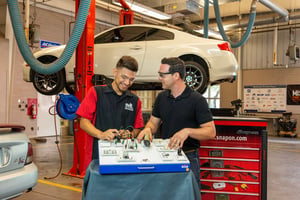 In the past, students who are nontraditional learners have faced challenges in typical school environments. But in recent years, many more opportunities have become available to these students. One such opportunity is trade school, which allows them to gain skills needed in diverse fields including transportation, tech, healthcare, hospitality, and culinary arts.
In the past, students who are nontraditional learners have faced challenges in typical school environments. But in recent years, many more opportunities have become available to these students. One such opportunity is trade school, which allows them to gain skills needed in diverse fields including transportation, tech, healthcare, hospitality, and culinary arts.
Vocational programs also tend to match the learning styles of students with dyslexia, ADHD, high-functioning Asperger’s, ADD, and auditory processing challenges. These learners have a 23 percent higher completion rate in trade schools than traditional four-year colleges.
What is it about these schools that helps bridge the gap faced by young adults who are nontraditional learners?
Hands-On Learning
Many vocational transportation programs use a hands-on lab setting to present actual automotive problems faced by car owners in the real world. This experience helps students go beyond textbook descriptions or simulated repair scenarios and dig right into the triumphs and challenges they will face in their professional career.
In an industry where working with your hands is a necessity, these real-world settings are crucial for students who learn differently from their peers. These opportunities provide an entry point into employment that might otherwise be hard to find.
Structure Mixed with Independence
Post-secondary education can be a great opportunity for nontraditional learners to find independence in their studies, allowing them to gain confidence in their skills. It lets them concentrate on what they can do, rather than be held back by what they can’t do.
In order to achieve this independence, trade schools offer a structure within which students can spread their wings. Regular testing and hands-on assignments help students focus their raw energy and apply it toward a greater purpose, often in a team setting, such as the floor of an auto repair shop. This structure forces students to manage their time and plan ahead for the next set of challenges.
Small Class Sizes
One thing you can expect at a traditional four-year college is that many courses will be held in large, packed lecture halls that seat hundreds of students. The chances of a professor knowing an individual’s learning style, or even their name, is slim at best.
Contrast this with a vocational school, which typically features smaller class sizes, allowing for personalized attention. In this more personal setting, students with learning differences are able to see their instructors as allies on their educational journeys.
Improved Social Skills
One-on-one relationships between students and teachers encourage learners who might shy away from social interactions to fully engage with their classmates and, eventually, their customers. Many careers within the transportation industry require working as part of a team and providing excellent customer service, which makes social skills all the more important for advancement.
Focused Coursework
Most four-year bachelor’s degree programs require a fair number of general education courses that fall outside of a student’s career track. An engineering major will have to take French or Spanish; a nursing student may find himself in art history. Vocational schools provide a more focused curriculum, which allows students to complete degrees much faster than in a traditional program.
The Right Fit
Life after high school is full of possibilities, but students who are nontraditional learners may face unique obstacles when pursuing a career through a standard, four-year institution. Vocational schools present an affordable, focused alternative that puts them on track to full-time employment in a field that plays to their strengths.
Are you interested in maximizing your learning capabilities? Take this quick learning assessment quiz to see what your dominant learning style is:




Comments